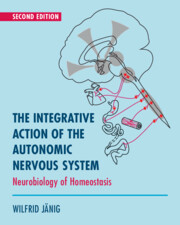Book contents
- The Integrative Action of the Autonomic Nervous System
- Reviews
- The Integrative Action of the Autonomic Nervous System
- Copyright page
- Dedication
- Contents
- Foreword to the Second Edition
- Foreword to the First Edition
- Preface
- Abbreviations
- Introduction The Autonomic Nervous System and the Regulation of Body Functions
- Part I The Autonomic Nervous System: Functional Anatomy and Interoceptive Afferents
- Part II Functional Organization of the Peripheral Autonomic Nervous System
- Part III Transmission of Signals in the Peripheral Autonomic Nervous System
- Part IV Representation of the Autonomic Nervous System in the Spinal Cord and Lower Brain Stem
- Chapter 8 Anatomy of Central Autonomic Systems
- Chapter 9 Spinal Autonomic Systems
- Chapter 10 Regulation of Organ Systems by the Lower Brain Stem
- Part V The Centers of Homeostasis in the Mesencephalon and Hypothalamus and Their Telencephalic Control
- Index
- References
Chapter 9 - Spinal Autonomic Systems
from Part IV - Representation of the Autonomic Nervous System in the Spinal Cord and Lower Brain Stem
Published online by Cambridge University Press: 16 July 2022
- The Integrative Action of the Autonomic Nervous System
- Reviews
- The Integrative Action of the Autonomic Nervous System
- Copyright page
- Dedication
- Contents
- Foreword to the Second Edition
- Foreword to the First Edition
- Preface
- Abbreviations
- Introduction The Autonomic Nervous System and the Regulation of Body Functions
- Part I The Autonomic Nervous System: Functional Anatomy and Interoceptive Afferents
- Part II Functional Organization of the Peripheral Autonomic Nervous System
- Part III Transmission of Signals in the Peripheral Autonomic Nervous System
- Part IV Representation of the Autonomic Nervous System in the Spinal Cord and Lower Brain Stem
- Chapter 8 Anatomy of Central Autonomic Systems
- Chapter 9 Spinal Autonomic Systems
- Chapter 10 Regulation of Organ Systems by the Lower Brain Stem
- Part V The Centers of Homeostasis in the Mesencephalon and Hypothalamus and Their Telencephalic Control
- Index
- References
Summary
The spinal cord is an autonomic integrative organ in its own right. Preganglionic neurons, autonomic interneurons and primary afferent neurons form spinal autonomic reflex circuits, which are integrated into the regulation of preganglionic activity by supraspinal centers. Autonomic premotor neurons projecting from the brain stem and hypothalamus to the spinal cord synapse with preganglionic neurons and autonomic interneurons. The discharge pattern in the different types of sympathetic neuron is associated with integration into the spinal cord, brain stem and hypothalamus. Reflex integration in the spinal cord is related to distinct afferent inputs from skin, deep somatic tissues and viscera. Spinal interneurons and preganglionic neurons constitute spinal autonomic motor programs that are integrated into the regulation of autonomic target organs. Spinal circuits, spinal afferent inflows and descending influences from the brain stem and hypothalamus work together and determine the activity of the preganglionic sympathetic neurons. This organization is exemplified in the regulation of evacuation and continence of urinary bladder and colon-rectum and in the regulation of the sequence of erection, emission and ejaculation of male reproductive organs. The functioning of these pelvic organs depends on multiple sacral and sacro-lumbar reflex circuits and several supraspinal integrative centers that interact with them.
Keywords
- Type
- Chapter
- Information
- The Integrative Action of the Autonomic Nervous SystemNeurobiology of Homeostasis, pp. 261 - 291Publisher: Cambridge University PressPrint publication year: 2022

